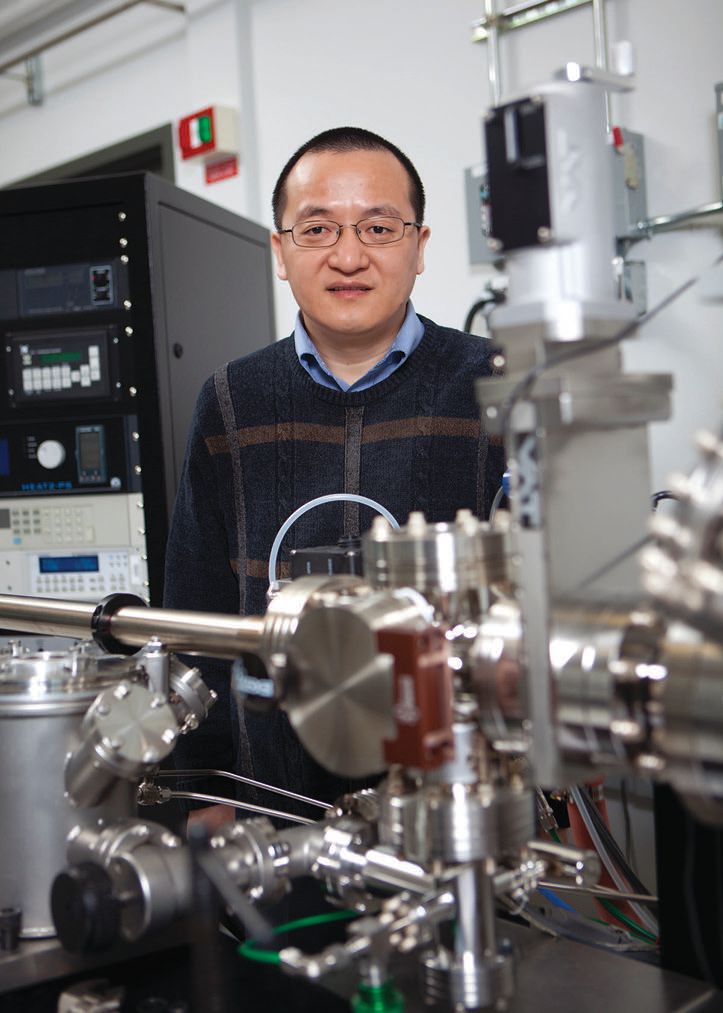Aluminum alloy acts to inhibit corrosion
Dr. Neil Canter, Contributing Editor | TLT Tech Beat March 2015
A new technique provides a better understanding of the oxidation of an aluminum alloy at high temperature.
KEY CONCEPTS
•
A low-energy microscope was used to study the surface oxidation of a nickel-aluminum alloy with a stepped surface structure.
•
Stripes formed from the oxidation of aluminum grow on the terraces, causing the steps connecting the terraces to bunch together.
•
This step-bunching process slows down and then eventually stops the growth of the aluminum oxide stripes.
THE GROWING USE OF ALUMINUM AND ITS ALLOYS IN COMMERCIAL APPLICATIONS is occurring to meet more demanding operating conditions and to improve the efficiency of machinery. This interest in using aluminum is prompting researchers to more closely examine the structure of aluminum alloys at the nanoscale.
A key mechanism responsible for metal failure is the growth and coalescence of voids originally produced during manufacture. In a past TLT article, transition state theory and atomistic simulations were used to predict whether nanoscale voids can cause metal fracture (
1). The result of this study is that the voids found in face-centered, cubic, aluminum simulation cells are too large to grow and create fractures.
Corrosion is another area where more research is underway at the atomic scale. The classic example of corrosion is the oxidation of steel to form rust. Aluminum forms an oxide coating when exposed to air at a neutral pH.
Initial thinking has been that surface oxidation of a metal substrate such as aluminum just occurs with little participation by the substrate. Guangwen Zhou, associate professor of mechanical engineering at Binghamton University-State University of New York in Binghamton, N.Y., says, “There has been extensive research on surface oxidation of metals but difficulty in determining the early stages of the process.”
The problem with figuring out how oxidation starts at the metal surface is attributed in part to the large number of defects present leading to inhomogeneities in the metal. Zhou says, “We have also not been able to detect the early stages of oxidation because of limitations with instrumentation. Better resolution has been needed.”
A new instrumental technique is now available and has been used to better understand the oxidation of an aluminum alloy at a high temperature.
STEP BUNCHING
Zhou (
see Figure 3) and his associates at Binghamton in conjunction with researchers at Brookhaven National Laboratory used a low-energy electron microscope (LEEM) to study the surface oxidation of a nickel-aluminum alloy with a crystal orientation of (100). He says, “This nickel-aluminum alloy was examined because it is used in high temperature applications such as gas turbine engines and in catalysis.”
 Figure 3. Associate Professor Guangwen Zhou led a group of researchers that determined the bunching of steps between terraces in a single nickel-aluminum alloy stopped surface oxidation of aluminum. (Figure courtesy of Binghamton University – State University of New York.)
Figure 3. Associate Professor Guangwen Zhou led a group of researchers that determined the bunching of steps between terraces in a single nickel-aluminum alloy stopped surface oxidation of aluminum. (Figure courtesy of Binghamton University – State University of New York.)
The nickel-aluminum alloy also has a stepped surface structure common to most crystalline materials. Zhou says, “The assumption is made that crystalline materials have relatively flat surfaces. This is in fact not the case because the surface exhibits roughness, which is characterized by a series of terraces or levels that are connected by single atom steps. These steps are very important in the oxidation process because the atoms exhibit low coordination numbers, which means they are more exposed to the environment including to oxidation.”
The experimental work was conducted in a controlled environment by introducing oxygen gas at a partial pressure in the range between 5.0 x 10
-10 to 2 x 10
-9 torr to a single crystal of the nickel-aluminum alloy at a temperature between 844 and 868 C. LEEM images were generated in real time to show how the surface of the alloy was oxidized.
The researchers found under the experimental conditions that oxygen reacted with the aluminum atoms to form aluminum oxide stripes that grow on the terraces. Nickel atoms are inert to oxygen and diffuse into the bulk under the experimental conditions.
LEEM analysis showed that the stripes grew due to the diffusion of aluminum and oxygen atoms on a specific terrace to the oxide growth front. Zhou says, “We define an adatom as an atom that detaches from surface steps and participates in the oxidation process by migrating to the leading edge of the oxide stripe.”
As oxygen continues to be introduced to the metal surface, the oxide stripes continue to grow. Zhou says, “The increased presence of oxide on the metal surface leads to the steps connecting the terraces bunching together ahead of the growth front of the oxide stripes. As a result, the growth of the oxide stripes slows down and eventually stops.”
Zhou continues, “The bunching of the steps makes it more difficult for adatoms to jump from one terrace to another, which enables the metal surface to literally stop oxidation.”
Increasing the pressure of the oxygen gas will lead to more oxide growth because there are more oxygen atoms available from the environment to react with aluminum atoms on the metal surface. Zhou says, “Even in the case of higher oxygen pressures, step bunching will eventually force the oxide stripes to stop advancing.”
If no more oxygen is introduced and the nickel-aluminum alloy is left in a vacuum at a high temperature, the aluminum oxide will decompose. Zhou says, “The oxide is unstable and will break down leading oxygen atoms to go back into the environment and aluminum atoms will move around on the surface to locations such as steps. Eventually the metal surface will revert back to its original structure.”
Crystal orientation also is an important factor with regard to oxide growth. The researchers evaluated a nickel-aluminum alloy with a (110) crystal orientation and compared it to the work done with the (100) orientation. Zhou says, “The (110) crystal orientation has a more open surface structure meaning that the aluminum atoms in the bulk of the metal can out-diffuse to the surface and participate in the growth of oxide stripes.”
Zhou intends to study other crystal orientations and compare the behavior to the (100) and (110) orientations. He says, “We also would like to study some real-world, polycrystalline materials, which are more complicated. Another future objective is to learn how to control the surface morphology to better control the density of the steps and control oxidation.”
The findings from this work may enable researchers to design a specific metal alloy to minimize oxidation leading to better performance over a longer operating period. Further information can be found in a recent article (
2) or by contacting Zhou at
gzhou@binghamton.edu.
REFERENCES
1.
Canter, N. (2012), “Effect of nanovoids on metal failure,” TLT,
68 (6), pp. 14-15.
2.
Qin, H., Chen, X., Li, L., Sutter, P. and Zhou, G. (2015), “Oxidation-driven surface dynamics on NiAl(100),”
Proceedings of the National Academy of Sciences,
112 (2), pp. E103-E109.
 Neil Canter heads his own consulting company, Chemical Solutions, in Willow Grove, Pa. Ideas for Tech Beat items can be sent to him at neilcanter@comcast.net
Neil Canter heads his own consulting company, Chemical Solutions, in Willow Grove, Pa. Ideas for Tech Beat items can be sent to him at neilcanter@comcast.net.